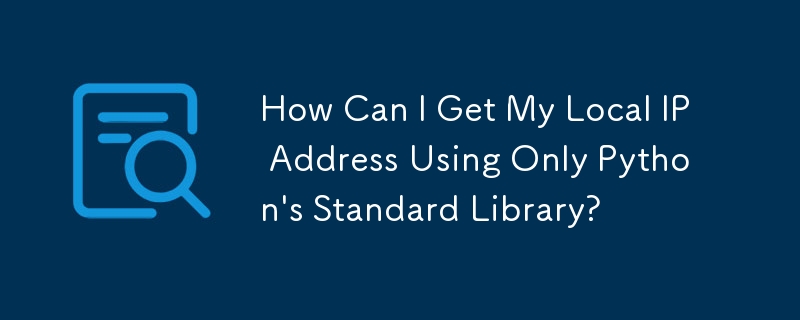 Backend Development
Backend Development
 Python Tutorial
Python Tutorial
 How Can I Get My Local IP Address Using Only Python's Standard Library?
How Can I Get My Local IP Address Using Only Python's Standard Library?
How Can I Get My Local IP Address Using Only Python's Standard Library?

Determining Local IP Addresses with Python's Standard Library
In Python, accessing local IP addresses can be achieved solely through the standard library. This method is platform-independent, allowing consistent behavior across operating systems.
To accomplish this, the socket module is employed. It provides a powerful way to interact with network protocols and perform various socket operations. Our specific task involves finding the local IP address, which can be retrieved by using the following sequence of steps:
- Create a socket object. This object represents a communication endpoint and can be configured to use specific protocols and socket types. In our case, we'll use the socket constructor with socket.AF_INET, which indicates an IPv4 socket, and socket.SOCK_DGRAM, signifying a datagram-oriented socket.
- Connect to a remote address. To retrieve the local IP address, we initiate a connection to a known remote host. Here, we choose to connect to the IP address "8.8.8.8," which belongs to Google's public DNS server. Port 80 is used, which is the standard port for HTTP traffic.
- Invoke getsockname(). After successfully establishing a connection, we can obtain the socket's local address by calling the getsockname() method on the socket object. This method returns a tuple containing two elements: the first one holds the local IP address, and the second one represents the port number that the socket is bound to.
- Extract the local IP address. From the tuple returned by getsockname(), we are primarily interested in the first element, which contains the local IP address as a string.
By following these steps and using the socket module, Python programs can effectively determine the local IP addresses available on their network interface.
The above is the detailed content of How Can I Get My Local IP Address Using Only Python's Standard Library?. For more information, please follow other related articles on the PHP Chinese website!

Hot AI Tools

Undresser.AI Undress
AI-powered app for creating realistic nude photos

AI Clothes Remover
Online AI tool for removing clothes from photos.

Undress AI Tool
Undress images for free

Clothoff.io
AI clothes remover

Video Face Swap
Swap faces in any video effortlessly with our completely free AI face swap tool!

Hot Article

Hot Tools

Notepad++7.3.1
Easy-to-use and free code editor

SublimeText3 Chinese version
Chinese version, very easy to use

Zend Studio 13.0.1
Powerful PHP integrated development environment

Dreamweaver CS6
Visual web development tools

SublimeText3 Mac version
God-level code editing software (SublimeText3)

Hot Topics
 How to solve the permissions problem encountered when viewing Python version in Linux terminal?
Apr 01, 2025 pm 05:09 PM
How to solve the permissions problem encountered when viewing Python version in Linux terminal?
Apr 01, 2025 pm 05:09 PM
Solution to permission issues when viewing Python version in Linux terminal When you try to view Python version in Linux terminal, enter python...
 How to avoid being detected by the browser when using Fiddler Everywhere for man-in-the-middle reading?
Apr 02, 2025 am 07:15 AM
How to avoid being detected by the browser when using Fiddler Everywhere for man-in-the-middle reading?
Apr 02, 2025 am 07:15 AM
How to avoid being detected when using FiddlerEverywhere for man-in-the-middle readings When you use FiddlerEverywhere...
 How to teach computer novice programming basics in project and problem-driven methods within 10 hours?
Apr 02, 2025 am 07:18 AM
How to teach computer novice programming basics in project and problem-driven methods within 10 hours?
Apr 02, 2025 am 07:18 AM
How to teach computer novice programming basics within 10 hours? If you only have 10 hours to teach computer novice some programming knowledge, what would you choose to teach...
 How to efficiently copy the entire column of one DataFrame into another DataFrame with different structures in Python?
Apr 01, 2025 pm 11:15 PM
How to efficiently copy the entire column of one DataFrame into another DataFrame with different structures in Python?
Apr 01, 2025 pm 11:15 PM
When using Python's pandas library, how to copy whole columns between two DataFrames with different structures is a common problem. Suppose we have two Dats...
 How does Uvicorn continuously listen for HTTP requests without serving_forever()?
Apr 01, 2025 pm 10:51 PM
How does Uvicorn continuously listen for HTTP requests without serving_forever()?
Apr 01, 2025 pm 10:51 PM
How does Uvicorn continuously listen for HTTP requests? Uvicorn is a lightweight web server based on ASGI. One of its core functions is to listen for HTTP requests and proceed...
 How to handle comma-separated list query parameters in FastAPI?
Apr 02, 2025 am 06:51 AM
How to handle comma-separated list query parameters in FastAPI?
Apr 02, 2025 am 06:51 AM
Fastapi ...
 How to solve permission issues when using python --version command in Linux terminal?
Apr 02, 2025 am 06:36 AM
How to solve permission issues when using python --version command in Linux terminal?
Apr 02, 2025 am 06:36 AM
Using python in Linux terminal...
 How to get news data bypassing Investing.com's anti-crawler mechanism?
Apr 02, 2025 am 07:03 AM
How to get news data bypassing Investing.com's anti-crawler mechanism?
Apr 02, 2025 am 07:03 AM
Understanding the anti-crawling strategy of Investing.com Many people often try to crawl news data from Investing.com (https://cn.investing.com/news/latest-news)...





